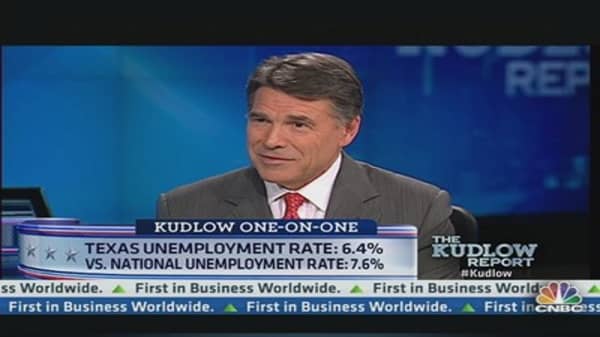Disappearing Deficits
U.S. state budgets suffered their worst downturn in 70 years from the Great Recession, according to the CPBB. More than half the states had deficits.
But many budget declines are evaporating, if not completely disappearing.
In the midst of an energy and agricultural boom, North Dakota is projecting a $1.6 billion surplus over its two-year budgeting cycle. Texas projects an $8.8 billion surplus over its current two-year budget cycle.
Florida, forced to make deep spending cuts in recent years, projects a $437 million surplus. Ohio expects a surplus of $1 billion, and Iowa a $484 million surplus, according to the National Association of State Budget Officers.
(Read More: Obamacare to Hurt Jobs? It's Happening, Poll Finds
The biggest turnaround may be in California. The Democratically controlled state legislature in Sacramento just approved a $96.3 billion budget, the third largest in state history, based on a projected surplus of nearly $4.4 billion. Only three years ago, California was running a $60 billion deficit.
Much of the credit for the surplus in the Golden State—coupled with spending cuts—goes to a tax increase voted on by California voters last November that ranged from 9.3 percent to 10.3 percent for individuals making $250,000 to 10.3 percent to 13.3 percent for those making at least $1 million annually.
Resisting the Urge to Squander
It's not just California seeing higher taxes turn to healthier budgets. In the fourth quarter of 2012, according to the Nelson A. Rockefeller Institute of Government, all state tax receipts were up 5.7 percent from the fourth quarter of 2011.
The CPBB reports that the typical state has collected 8.9 percent more in personal income taxes so far this year than in the same period in 2012. Seven states Florida, Texas, Nevada, Washington, South Dakota, Wyoming and Alaska, don't have a personal income tax.
But states are in danger of reversing their progress if they spend now or try turning surpluses into tax cuts.
"States have to work on a careful balance when it comes to taxes," said Stanley Veliotis, a tax professor at Fordham University.
"On the one hand, they can't raise taxes too high and force businesses and people to move to states with less taxes," Veliotis explained. "On the other hand they can't lower taxes too much and lose out on revenue."
Some states are using their new found money to restore cuts in education and infrastructure—Florida is looking to increase teacher pay, and Tennessee is expected to spend more on health care and its prison system.
California is putting some of its money away for a rainy day fund besides increased spending on education and healthcare.
Others, like Ohio, Iowa and Indiana have lawmakers pushing for state tax cuts.
"States are thinking about cuts, but I think they need to wait and see whether economic growth can continue," said McNichol. "It doesn't make sense to cut taxes now if they're such a main source of revenue."
Future for States?
Of concern for state revenues going forward, according to the CPBB, is that many states still have income tax systems with flat or nearly flat rates, And budget funding levels at states are still below pre-recession levels.
States also have to think about how their future is tied to Capitol Hill.
Read more: Cisco CEO: US Tax System Is Broken)
The federal government, which provides one quarter of state revenues, is cutting back on funding for schools and non-entitlement grants from cuts implemented in 2011. There could be more cutbacks to states on future budget deals out of Washington.
McNichol adds that instead of new programs, states should focus their new found wealth on current problems.
"They should be very cautious about what they do. It should be one time spending needs like infrastructure and paying down their debt instead of new programs," she said.





